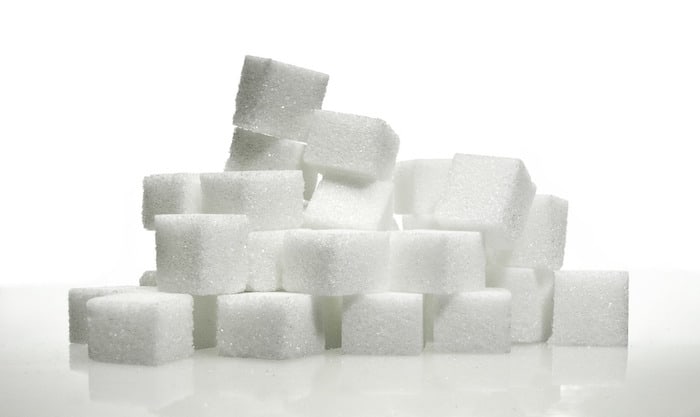We all know that sugar isn’t great for us. And if it were easy to not add that extra scoop of sweetness to our morning coffee, cutting it out would be no problem.
Unfortunately, comfort foods (like many high-sugar foods) are a large part of our culture. From grabbing a doughnut after a stressful day to celebrating a birthday with cake, there seems to be a sugar-loaded food for every occasion. But if a stressful day or happy celebration has you reaching for some double layered chocolate cake, you may want to think again. Read on for information on all things sweet, including which types of sweeteners to avoid, where they’re hiding, and how to kick the habit for good.
Harmful Effects
Sugar is present in 75% of all packaged foods both to add flavor and for its addictive quality. Studies have shown that sugar has a similar effect on the brain as drugs like cocaine and nicotine. Therefore, it’s beneficial for food manufacturers to add it to their food to keep you coming back for more. While it may be tasty, there are plenty of reasons to cut sugar from your daily regimen. Sugar can lead to weight gain, rot teeth, increase the risk of type 2 diabetes, and increase risk of death by heart disease even if you aren’t overweight. Sugar has also been linked to larger waistlines, increased risk of cancer, and a decreased lifespan.
Where You’re Eating It
One of sugar’s most dangerous traits is that it hides in places we may never think to look. Yes, the dessert aisle is a clear example of a sugar-high waiting to happen and a large amount of the population’s sugar intake does comes from obvious treats like cookies, cakes, and pastries. But the biggest source of added sugar to diets is soda, energy drinks, and sports drinks. Aside from those main contenders, food items such as pre-made salad dressing, tomato sauce, fruit juices, bread, crackers, and breakfast cereals (some which have three or four different types of added sweeteners) all contain large quantities of the sweet stuff.
Sugar By Any Other Name…
This information may seem daunting but there are simple steps you can take to begin reducing the amount of sugar in your diet. One of the best ways to keep your sugar intake low is to read nutrition labels. Ingredients on a nutrition label are listed according to how much of each ingredient is in the food — from most to least. If sugar is one of the first ingredients listed, be cautious; this means it is one of the product’s main ingredients.
While looking for sugar on food labels may seem simple enough, this process gets slightly more complicated by the fifty-six other names that sugar can go by. If you can’t memorize all 56, look for these common culprits: agave nectar, maltodextrin, corn syrup, fructose, glucose, maltose, high-fructose corn syrup, turbinado, dextrose, honey, sucrose, and molasses. (Anything with sugar or syrup in the name is almost a sure-fire giveaway that we’re talking about sugar.)
Almost all processed foods (foods that aren’t in their natural state or come in some sort of packaging) will come with some added sugar. The easiest way to reduce sugar from your diet (with the least amount of effort) is to cut back on anything processed including beverages. If your diet is currently heavy on processed foods, try to add more whole foods including lean meats, and fresh fruits and veggies. Find yourself snacking on chips and crackers? Swap that out for celery or carrot sticks with hummus or natural peanut butter or a baked sweet potato with a little bit of butter.
Healthy Intake
The World Health Organization, along with the Dietary Advisory Committee, recommends limiting sugar to less than 10 percent of total calories consumed each day, including both added and natural sugars. If you’re following a 1500 calorie diet, this would mean eating less than 150 calories or about 9 teaspoons of sugar a day. For a 2000 calorie diet, it would mean eating less than 200 calories or 12 teaspoons of sugar a day.
The American Heart Association recommends that women have no more than 26 grams of sugar a day and that men do not exceed 37.5 grams a day (this is equal to about 6 teaspoons for women and 9 teaspoons for men). To put that in perspective, a single can of Coca-Cola has 33 grams of sugar, one medium sized banana contains 16 grams of sugar and one piece of chocolate cake has about 26 grams of sugar. The AHA’s limit applies only to added sugars, meaning sugars that do not occur naturally in foods. Fruits, vegetables, and dairy all contain natural sugars that do not exist in high enough quantities to cause health problems (but the WHO still recommends watching your natural sugar intake).
How To Cut It Out For Good
The best way to cut sugar out of your diet is to do so gradually. If you feel like your diet is on par with the Cookie Monster’s, reducing your intake will be difficult at first. Quitting cold turkey can lead to intense cravings, and in some cases, withdrawal like symptoms. These do get better, though! And cutting sugar from your diet comes with a plethora of health benefits. It can reduce your risk of disease, give you more energy, help you to reach a healthy weight, and may even takes years off your look!
Real results with a personalized weight loss program
Take the quiz!

Make a game plan for how you to plan to reduce your sugar intake. If you’re drinking a lot of soda, begin by cutting back by one per week, and continue to decrease gradually until you no longer crave it. Beware of low-fat products as a healthy substitute — they normally contain sugar to add flavor. When reading labels, beware of products with sugar as a main ingredient. Try to pick foods that say “unsweetened” or “no sugar added.” Finally, add in lean proteins and healthy fats (avocados, nuts, fish, and nut butters) to keep yourself full and satisfied.
Sugar seems to be everywhere in our current food culture. But you can reduce your intake. Try to eat whole foods and stick to the outside of the grocery store where fresh fruits, veggies, and meats are stored. Check labels and be cautious of products with heavily added sugar. Most importantly, start to become aware of what you’re putting into your body. It’s well worth it.




